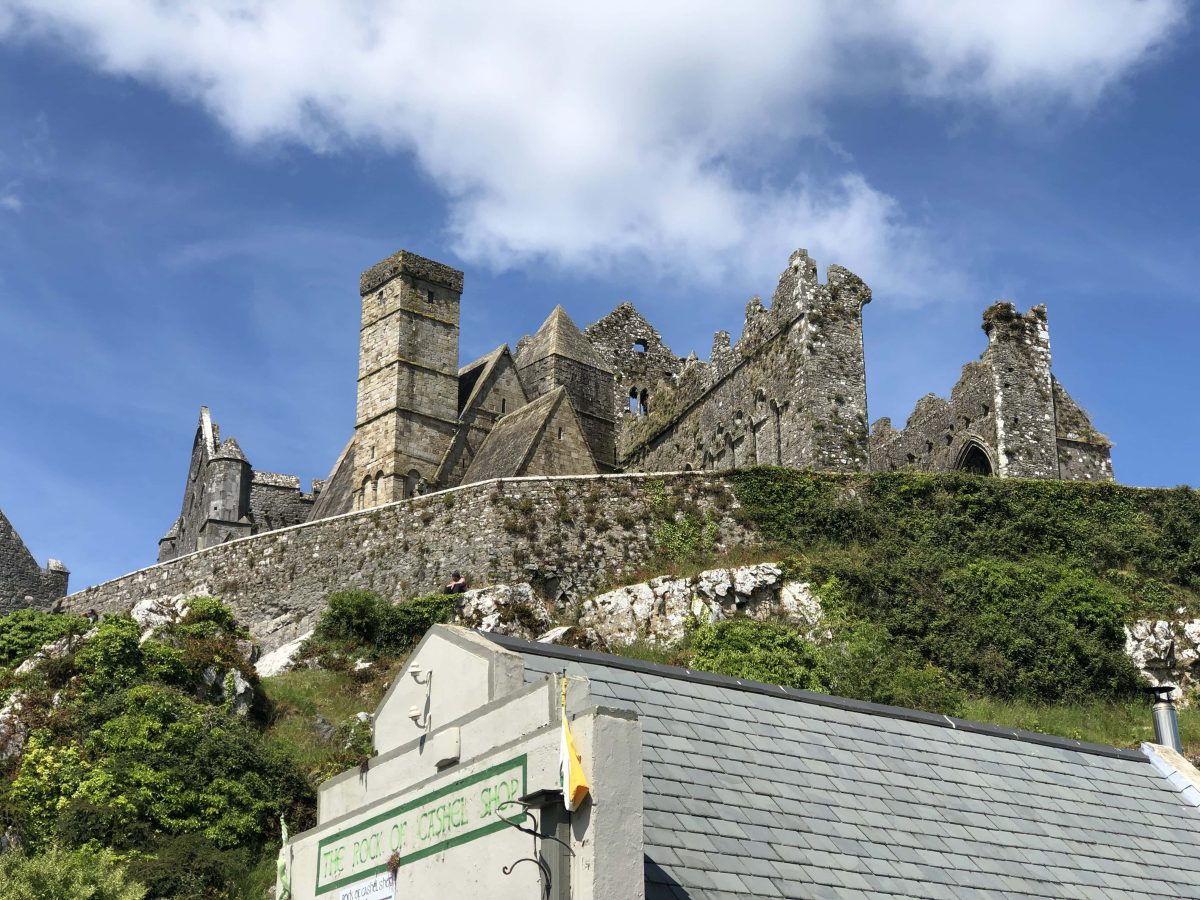Sited on a steep hill that towers above the vast green plains of Co. Tipperary, the Rock of Cashel is a grand and dramatic ruin from Ireland’s medieval past. Originally a secular site associated with the Kings of Munster (one of the Ireland’s traditional provinces) and later with the High Kings of Ireland, it also has connections with St. Patrick and is sometimes called St. Patrick’s Rock. Then, it officially became a religious site when a member of the powerful O’Brien family gave it to the church in 1101.
It was as an ecclesiastical site that the Rock of Cashel saw some of the most dramatic episodes in Ireland’s history.1 All the buildings visible today date from its religious phase, though the entire complex still has a fortress-like atmosphere. It feels like a medieval epic movie should be set there. For a small entrance fee, you can visit the Rock of Cashel and tour its five surviving buildings.
Cormac’s Chapel








Exterior, interior, and carvings of Cormac’s Chapel on the Rock of Cashel. Photos by A Scholarly Skater.
By far, the most interesting structure on the Rock is the small Hiberno-Romanesque (Irish Romanesque) chapel, which was built between 1127 and 1134 CE. It’s called Cormac’s Chapel in honor of its patron Cormac Mac Cárthaigh (McCarthy), who was both Archbishop of Cashel and King of Munster. In addition to being one of the first Romanesque buildings in Ireland, the chapel is also notable for mixing elements of traditional Irish architecture with influences from England and continental Europe.2 For example, the steeply-pitched roof is traditionally Irish, while the square towers come from German architecture, and the chevrons decorating the arches are typical of English Romanesque. Additionally, a sarcophagus for Cormac’s brother with Norse-style animal interlace decoration rests inside the building. According to my tour guide, the resulting building was Cormac’s statement about his (and Ireland’s) connection with the rest of the Christian world as well as his method of solidifying his family’s lasting power on this important site.



Surviving Romanesque wall paintings inside the apse of Cormac’s Chapel. Photos by A Scholarly Skater.
Things get even more exciting on the interior, which has some incredibly rare survivals – Romanesque wall paintings in the apse!3 Although they are quite fragmentary, you can still make out scenes of the Magi and the Baptism of Christ as well as more figurative and decorative imagery. There are also some great carvings throughout, including lots of little heads on the corbels (a motif I saw repeated elsewhere in Ireland) and a pair of carved tympana over the entryways. Be sure to check out the carvings on the north facade, since they’re the best preserved because later buildings shelter them from the elements. Plus, the only gargoyle I saw in Ireland, a modest little fellow, perches on the chapel’s exterior.

Cormac’s Chapel is made entirely of regularly-cut blocks of sandstone, which really stand out amongst the other limestone or granite buildings. The effect is beautiful, but since sandstone is not durable, the chapel is actually quite fragile despite appearing to be fairly intact. In particular, it is very susceptible to humidity. For this reason, access to the interior of Cormac’s Chapel is limited to guided tours with carefully controlled numbers. More on this later.
The Cathedral

Next to Cormac’s Chapel is a larger and later Gothic church. Although titled a cathedral because it was the seat of the Archbishop of Cashel, it’s relatively modest in size and lacks aisles altogether. It’s also oddly shaped; the choir and transept arms are longer than the nave! This is because of the limitations posed by the site – an outcropping of fixed size with many graves and a chapel already in place when work on the cathedral began. You can tell how the builders struggled to fit it in by the way it awkwardly abuts Cormac’s Chapel and the round tower and even blocks off the chapel’s northern entrance entirely. The cathedral is broadly Gothic, since it has things like pointed arches and rib vaults, but it’s far from a textbook example of the style.

Adjacent to the cathedral is a 15th-century tower house constructed for the Archbishop. Unfortunately, visitors can’t actually enter the tower because of extensive damage caused by a storm in 1848.4 Impressively, a huge chunk of masonry still lays right where it fell almost two centuries ago. The cathedral itself isn’t in great shape either and has lost most of its vaults. However, you can still see some surviving rib vault at the crossing, a few chapels, several grave monuments, and a section of medieval wall painting that has been glassed-over for its protection. The church is officially named St. Patrick’s Cathedral but should not be confused with the grander Gothic church of the same name in Dublin.
More buildings


In addition to the cathedral and chapel, the Rock of Cashel also contains several other noteworthy features. An intact round tower built around 1103 is the oldest structure remaining on the site and is very similar to the tower at Glendalough. There are two 15th-century residential buildings that have been fully reconstructed and furnished. One originally housed the choir who sang in the cathedral, and it is surprisingly homey. A large, decaying medieval stone cross with scenes of St. Patrick has been moved inside for preservation – usually accessible but not during my visit – while a replica takes its place outside.

The entire rock is surrounded by a stone wall, and most of the remaining ground around the buildings is taken up with graves. People are sometimes still buried here, which is why the staff reminds people to be behave appropriately. But don’t let the graveyard discourage you from walking around and enjoying stunning views of the lovely plains (and the horses, cows, and sheep who inhabit them) below. You can see for miles in all directions. The view up at the Rock from below is pretty great, too.
Practicalities

Click here for information about visiting the Rock of Cashel.
For all its importance, the Rock of Cashel is not large, so you’ll need no more than two hours there. Admission costs €8 for adults, and that allows you to join a guided tour whenever there is one. (I get the sense that the tour schedule changes frequently.) I recommend doing so, since it’s the only way to learn about what you’re seeing. If you want to see the inside of Cormac’s Chapel, that’s an extra €2 or €3. As I mentioned before, admittance to the Chapel is limited because the sandstone and paintings are both sensitive to the humidity that visitors supply in mass. I had no trouble getting a slot, but it might be more difficult on a weekend or in the middle of summer. Either way, you can walk around the site as much as you want before or after your hour-long tour, but you can’t go back into the chapel again.
Looking up at the Rock of Cashel from the town below made me think that I was in for a real workout walking to the site. Fortunately, the path isn’t quite as long and steep as it looks from the bottom, but it’s still an incline. Cars aren’t allowed up the hill, but if you need assistance, I suspect you can get some with advanced notice. Once you get up there, the terrain can definitely be uneven, and the tour guide warned us to watch our step. Fortunately, there’s nowhere near as much ground to cover as at Glendalough and little chance of getting lost.
I think the only preparation you really need is to wear good walking shoes and dress in layers. I’ve heard it can be cold and windy, but that was not my experience. If you’re hungry, you can walk down the hill and get food in Cashel, a little town that doesn’t at all seem like someplace with a major tourist attraction. I had lunch at Ladyswell Restaurant on the High Street; it looked humble from outside, but the food was excellent. There are also a few nice shops on the path that leads to the Rock, and I think one or two of the sell water and snacks.
Despite its significance and popularity, there’s no easy way to get to the Rock of Cashel using public transportation. I managed it with a combination of train and taxi, but I don’t recommend this. You can drive – there is paid parking at the bottom of the hill – but since the Irish drive on the left, this is probably unwise for foreign visitors. Otherwise, going with a tour group is probably your best option. I think a lot of tour buses pair this site with Blarney Castle and/or locations in Cork.
Notes/Sources
- For a fuller history of the Rock of Cashel, see http://www.thestandingstone.ie/2022/03/the-rock-of-cashel-co-tipperary.html ↩︎
- https://smarthistory.org/cormacs-chapel/ ↩︎
- https://heritageireland.ie/articles/conservation-works-at-cormacs-chapel-rock-of-cashel-co-tipperary/ ↩︎
- http://www.thestandingstone.ie/2022/03/the-archbishops-residence-rock-of.html ↩︎



